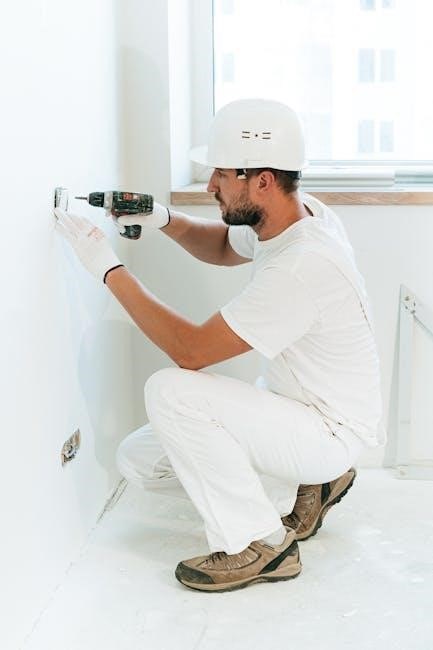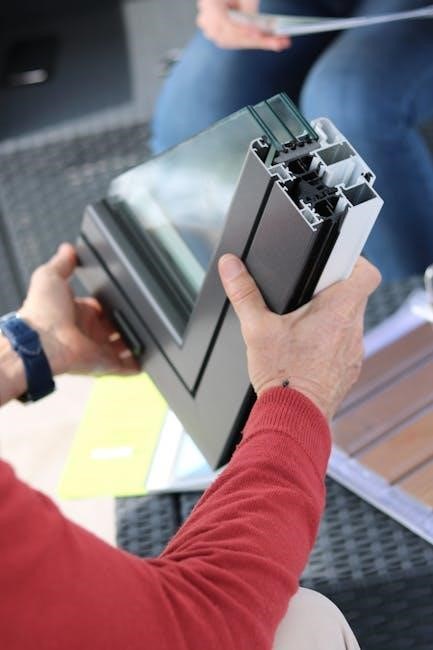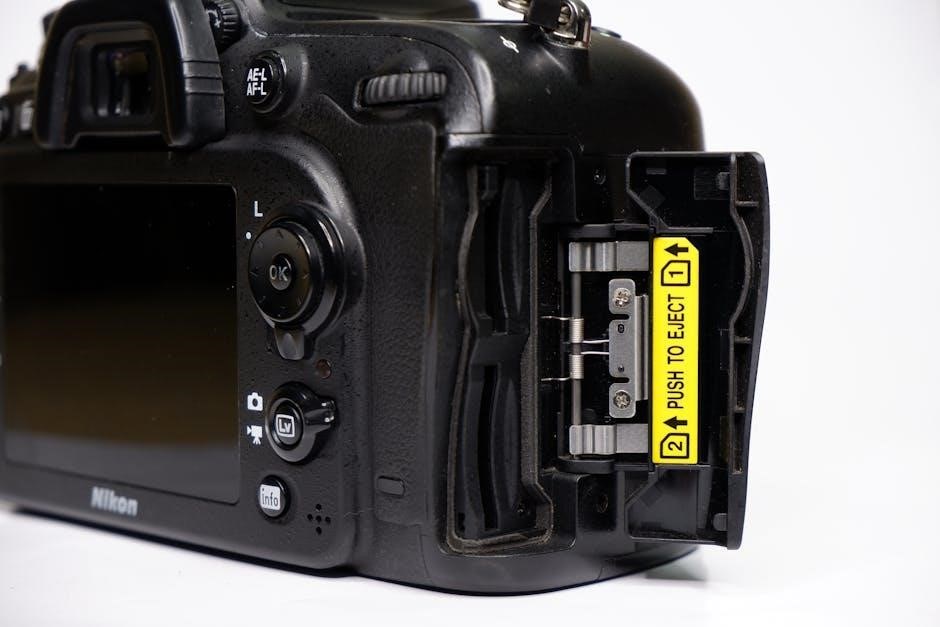Welcome to the XNX Transmitter Installation Manual. This guide provides comprehensive instructions for installing, configuring, and maintaining the XNX Universal Transmitter. Ensure safety and compliance by following all procedures carefully.
Overview of the XNX Universal Transmitter
The XNX Universal Transmitter is a flexible and versatile gas detection solution designed for use in hazardous areas worldwide. It supports a wide range of gas sensing technologies, including electrochemical and infrared (IR) sensors, making it suitable for detecting various gases in industrial settings. The transmitter features integral mounting tabs for easy installation on walls, pipes, or other surfaces, ensuring adaptability to different environments. Its modular design allows for simple integration with additional components, such as relay boards or HART barriers, while maintaining a user-friendly operation. The XNX Universal Transmitter is certified to global standards, ensuring reliability and safety in explosive environments. Its robust construction and advanced features make it an ideal choice for industries requiring accurate and dependable gas monitoring systems.
Purpose of the Manual and Safety Guidelines
This manual is designed to provide detailed instructions for the safe and effective installation, operation, and maintenance of the XNX Universal Transmitter. It serves as a comprehensive resource for technicians and users to ensure optimal performance and compliance with safety standards. Before proceeding, it is essential to read and understand all sections of this manual carefully. Safety guidelines are emphasized throughout to prevent accidents and ensure reliable operation in hazardous environments. Always follow local regulations and use certified components for installation. Proper mounting, wiring, and configuration are critical to avoid potential hazards. Adhering to these guidelines will help maintain the integrity of the system and ensure the safety of personnel and facilities.

Safety Precautions and Warnings
Adhere to recognized safety standards and use certified components. Avoid high inrush or inductive loads to ensure reliable operation. Always follow warnings and cautions outlined in this manual.
General Safety Guidelines for Installation
Always follow recognized safety standards and regulations during installation. Ensure the transmitter is installed in accordance with local and international hazardous area certifications. Use only certified cable glands and avoid high inrush or inductive loads to prevent performance issues. Keep the transmitter enclosure closed during operation unless in a non-hazardous area. Read and understand this manual thoroughly before starting any installation tasks. Pay close attention to all warnings and cautions provided in the document. Proper grounding and bonding are essential to ensure safe operation. Use shielded, armored cables for wiring to minimize interference. Never install or commission the transmitter without proper training and authorization. Safety guidelines must be strictly followed to avoid risks and ensure optimal performance.
Hazardous Area Considerations and Certifications
The XNX Universal Transmitter is certified for use in hazardous areas worldwide, adhering to global standards such as ATEX and IEC. Ensure installation complies with recognized international and local regulations. Use only certified M25 cable glands and maintain proper grounding and bonding to prevent ignition risks. The transmitter is designed for safe operation in explosive atmospheres when installed according to the manual. Always verify the certification details for the specific gas detection application. Proper mounting and location are critical to ensure compliance with hazardous area classifications. Follow all relevant standards for wiring and connections in hazardous environments. This ensures the transmitter operates safely and reliably in potentially dangerous locations.

Mounting the XNX Transmitter
The XNX Transmitter offers flexible mounting options, including wall and pipe installations, using integral mounting tabs for secure and stable attachment to various surfaces or pipes.
Wall Mounting Options and Procedures
The XNX Transmitter can be securely mounted to a flat wall surface using its integral mounting tabs. Ensure the surface is sturdy and even. Use ¼-20 UNC screws or M6 metric equivalents, depending on regional standards. Tighten the screws firmly but avoid over-tightening to prevent damage. For added stability, ensure the mounting tabs are aligned properly with the wall anchors. Refer to the technical manual for specific torque recommendations. Always follow local safety standards and regulations during installation. This method provides a reliable and straightforward solution for wall mounting, ensuring optimal performance and durability of the transmitter in various environments.
Pipe Mounting Methods and Flexibility
The XNX Transmitter offers versatile pipe mounting options, enabling installation on horizontal or vertical pipes. Use the integral mounting lugs on the transmitter body for secure attachment. Ensure the pipe is sturdy and properly sized to support the transmitter’s weight. For horizontal pipes, align the lugs with the pipe’s center to maintain balance. Vertical pipe mounting allows for flexibility in tight spaces. Avoid over-tightening to prevent damage to the lugs or transmitter housing. Ensure proper alignment to minimize vibration effects. This method is ideal for industrial settings where wall space is limited. Refer to the technical manual for specific torque specifications and compatibility guidelines. Pipe mounting ensures reliable performance and adaptability in various installation environments.

Installing the Sensor
The XNX Transmitter supports various sensor types, including electrochemical and infrared models. Ensure correct installation by following specific steps for each sensor type to guarantee accurate gas detection.
Electrochemical Sensor Installation Steps
For optimal performance, install the electrochemical sensor according to the following steps. Begin by ensuring the sensor is compatible with the XNX transmitter. Connect the sensor to the designated junction points, typically J1 and J2, ensuring secure wiring. Use a local HART IS barrier if required for intrinsic safety. Mount the sensor in a location that minimizes exposure to contaminants and ensures proper gas flow. Tighten all connections to avoid signal interference. Power up the transmitter and verify sensor recognition. Perform calibration as outlined in the technical manual to ensure accurate gas detection. Refer to the XNX Universal Transmitter Technical Manual for detailed procedures and safety guidelines.
Infrared (IR) Sensor Installation Requirements
The Infrared (IR) sensor installation requires careful planning to ensure accurate gas detection. Begin by selecting a location free from obstructions and interference. Ensure proper alignment of the IR sensor to avoid signal degradation. Use the provided mounting hardware to secure the sensor, ensuring stability and minimal vibration. Connect the sensor to the XNX transmitter using the designated cable entries, following the wiring diagram in the technical manual. Ensure all connections are tight and shielded to prevent interference. Power up the system and perform a zero-calibration check. Verify the sensor’s response to the target gas and adjust the alignment if necessary. Refer to the XNX Universal Transmitter Technical Manual for specific calibration procedures and safety guidelines to ensure reliable operation.

Wiring and Connections
Use Honeywell-certified M25 cable glands for hazardous areas. Ensure proper shielding and avoid grounded cables. Follow wiring diagrams in the technical manual for accurate connections. Secure all connections and ground according to local regulations.
Connecting the Sensor to the Transmitter
Connect the sensor to the XNX transmitter using the appropriate cable and ports. For electrochemical sensors, ensure the J1 connector is securely attached to the transmitter. If using a HART-compatible sensor, connect it to the designated HART port. Properly ground the sensor to avoid interference. Use the correct cable glands for hazardous areas and ensure all connections are tight. Refer to the technical manual for specific wiring diagrams. For infrared sensors, follow the manufacturer’s guidelines for alignment and signal strength. Always verify connections before applying power. Incorrect connections may result in faulty readings or damage to the transmitter. Ensure compliance with local electrical standards and safety protocols during the process.
Power Supply and Wiring Considerations
The XNX transmitter requires a stable power supply to ensure reliable operation. Use a power source compatible with the transmitter’s specifications, typically 24V DC. Avoid high inrush or inductive loads, as they may affect performance. For resistive loads, ensure proper wiring to maintain signal integrity. When connecting sensors, use shielded cables in hazardous areas to minimize interference. Ground the transmitter and sensor correctly to prevent noise and ensure accurate readings. Follow local electrical codes and certification standards, such as ATEX or IEC, for wiring in explosive environments. Use approved cable glands and maintain tight connections to prevent moisture ingress. Regularly inspect wiring for damage or corrosion to guarantee optimal performance and safety.

Calibration and Configuration
The XNX transmitter requires precise calibration for accurate gas detection. Configuration involves setting gas type, range, and alarm levels. Follow the manual’s detailed procedures for optimal performance.
Calibration Procedures for Gas Detection
Calibration is essential for ensuring accurate gas detection with the XNX transmitter. Begin by connecting the sensor and powering on the device. Use zero and span gases to set the baseline and range. Follow the manual’s step-by-step guide for precise adjustments. Allow the sensor to stabilize before recording readings. Ensure the gas type and range are correctly configured. Perform a functionality check post-calibration to verify accuracy. Refer to the technical manual for detailed procedures and safety guidelines to maintain compliance and optimal performance.
Configuring the Transmitter for Specific Gases
Configuring the XNX transmitter for specific gases ensures precise detection and accuracy. Start by selecting the gas type from the menu, ensuring compatibility with the installed sensor. Follow the manual’s instructions to set the concentration range and alarm levels. For electrochemical sensors, input the correct gas parameters, while for infrared sensors, configure the IR absorption parameters. Use the HART protocol for advanced configuration if required. Verify settings by reviewing the transmitter’s display or using software tools. Ensure all configurations align with the gas type and application requirements. Proper setup guarantees reliable performance and compliance with safety standards. Always refer to the technical manual for gas-specific guidelines and calibration needs.

Troubleshooting and Maintenance
Regularly inspect and clean sensors, check wiring connections, and verify power supply. Use diagnostic tools to identify faults and follow procedures in the technical manual. Ensure proper HART communication for advanced diagnostics and maintenance tasks.

Common Issues and Solutions
Troubleshooting the XNX Transmitter involves identifying and resolving common issues. Sensor drift, incorrect calibration, or faulty wiring are frequent problems. For sensor drift, recalibrate using the appropriate gas and follow manual guidelines. Communication errors with HART or Foundation Fieldbus can occur; check wiring integrity and ensure proper configuration. Power supply issues may cause malfunctions; verify voltage levels and connections. If alarms persist, reset the transmitter and recheck settings. Regular maintenance, such as cleaning sensors and updating software, prevents downtime. Always refer to the technical manual for detailed diagnostic procedures and solutions to ensure optimal performance and safety.
Regular Maintenance Tasks for Optimal Performance
Regular maintenance ensures the XNX Transmitter operates efficiently and accurately. Clean the sensor periodically to prevent contamination and ensure accurate gas detection. Check and replace the sensor filter as needed to maintain performance. Inspect electrical connections for tightness and integrity to avoid signal disruptions. Perform routine calibration checks and adjust settings as required. Update software and firmware to benefit from the latest features and improvements. Schedule periodic inspection of wiring and cables for wear or damage. Document all maintenance activities for tracking and compliance. Always follow the manufacturer’s guidelines and safety protocols during maintenance to ensure reliability and longevity of the transmitter.
This concludes the XNX Transmitter Installation Manual. Proper installation, configuration, and maintenance are essential for optimal performance and safety. Refer to the Technical Manual (P/N 2104M0506) for detailed calibration procedures and troubleshooting. For additional support, visit Honeywell Analytics’ official website or contact their customer service. The XNX Universal Transmitter Resource CD (Honeywell part number 1998-0748) provides comprehensive documentation, including user manuals and technical guides. Regularly check for software and firmware updates to ensure your transmitter operates with the latest features. Always follow safety guidelines and manufacturer recommendations for installation and maintenance. For further assistance, consult the XNX Foundation Fieldbus Manual or the HART Manual for specific configurations. Ensure compliance with local regulations and standards for hazardous area installations.




About the author